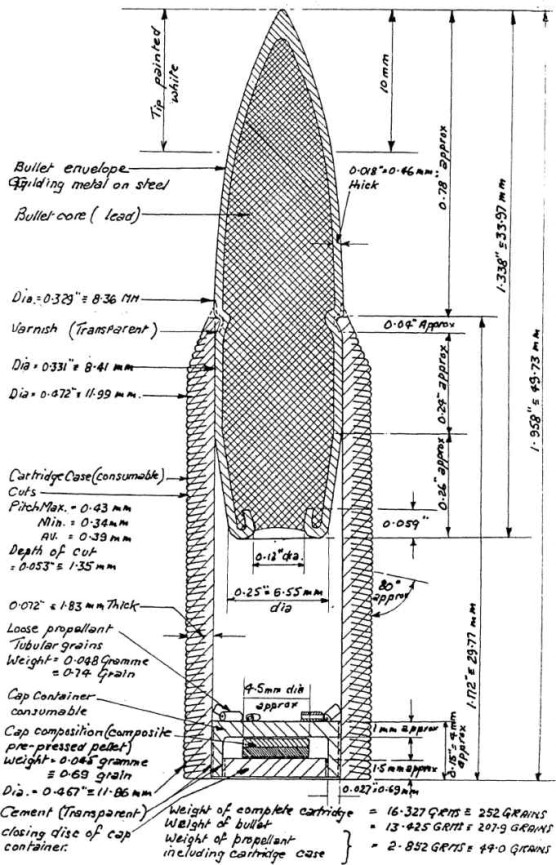
Some German research was far ahead of its time; this
remarkable drawing of a caseless cartridge – one using a solid block of
propellant to support the bullet instead of a brass cartridge case – was
discovered in 1945, but it was to be another 40 years before the idea was
successfully incorporated into a practical weapon system.
During World War II, Germany began an intensive program to
research and develop a practical caseless ammunition for military use, which was
driven by the rising scarcity of metals, especially copper used to make
cartridge cases. The Germans had some success, but not sufficient to produce a
caseless cartridge system during the war.
WWII – Germans experiment with caseless ammunition – Formed
Nitrocellulose (NC) employed to save “strategic materials” (brass). Steel cases were used instead.
Nitrocellulose or “guncotton” is formed by the
action of nitric acid on cellulose fibers. It is a highly-combustible fibrous
material that deflagrates rapidly when heat is applied. It also burns very
cleanly, burning almost entirely to gaseous components at high temperatures
with little smoke or solid residue. The burning rate of nitrocellulose is
dependent upon the pressure a pile of uncontained nitrocellulose will burn
slowly, with a high, bright flame, but when placed in a high-strength, sealed
container, the same material will burn very quickly, bursting the container. Nitrocellulose,
the primary component of modern, ignites at a relatively low temperature of
around 170 °C (338 °F).
Gelatinised nitrocellulose is a plastic, which can be formed
into many shapes of gun propellants such as cylinders, tubes, balls, and
flakes. The size and shape of the propellant grains can increase or decrease
the relative surface area, and change the burn rate significantly. Additives
and coatings can be added to the propellant to further modify the burn rate.
Normally, very fast powders are used for light-bullet or low-velocity pistols
and shotguns, medium-rate powders for magnum pistols and light rifle rounds,
and slow powders for large-bore heavy rifle rounds. These are known as
Single-base propellants.
Solid propellants (caseless ammunition)
A recent topic of research has been in the realm of
“caseless ammunition”. In a caseless cartridge, the propellant is
cast as a single solid grain, with the priming compound placed in a hollow at
the base, and the bullet attached to the front. Since the single propellant
grain is so large (most smokeless powders have grain sizes around 1 mm, but a
caseless grain will be perhaps 7 mm diameter and 15 mm long), the relative burn
rate must be much higher. To reach this rate of burning, caseless propellants
often use moderated explosives, such as RDX. (Caseless ammunition might be
considered a return to the mid-19th century, since the first practical
cartridge repeater, the “Volcanic” pistol, used a charge of black
powder in a cavity in the bullet base. This weapon was the direct ancestor of
the Henry and Winchester rifles, though they switched to metal-cased
ammunition. Some early rifles and revolvers also used combustible-paper
cartridges, but they required a separate ignition system.) The major advantages
of a successful caseless round would be elimination of the need to extract and
eject the spent cartridge case, permitting higher rates of fire and a simpler
mechanism, and also reduced ammunition weight by eliminating the weight (and
cost) of the brass or steel case.
While there is at least one experimental military rifle (the
H&K G11), and one commercial rifle (the Voere VEC-91), that use caseless
rounds, they are meeting little success. The caseless ammunition is of course
not reloadable (a major disadvantage in civilian markets, where reloading is
common) and the exposed propellant makes the rounds less rugged. Also, the case
in a standard cartridge serves as a seal, keeping gas from escaping the breech.
Caseless arms must use a more complex self-sealing breech, which increases the
design and manufacturing complexity. Another unpleasant problem, common to all
rapid-firing arms but particularly problematic for those firing caseless
rounds, is the problem of rounds “cooking off”. This problem is
caused by residual heat from the chamber heating the round in the chamber to
the point where it ignites, causing an unintentional discharge.
Belt-fed machine guns or magazine-fed submachine guns
designed for high volumes of fire usually fire from an open bolt, with the
round not chambered until the trigger is pulled, and so there is no chance for
the round to cook off before the operator is ready. Such weapons could use
caseless ammunition effectively. Open-bolt designs are generally undesirable
for anything but belt-fed machine guns and pistol-cartridge submachine guns;
the mass of the bolt moving forward causes the gun to lurch in reaction, which
significantly reduces the accuracy of the gun. Since one of the motivating
factors for the use of caseless rounds is to increase the rate of fire to the
degree that several shots can be fired to the same point of aim, anything that
reduces the accuracy of those first shots would be counterproductive. Cased
ammunition serves as a heat sink, to carry heat away from the chamber after
firing; the hot case carries away much of the heat before it can transfer to
the chamber walls, and the new case absorbs heat from the chamber, reducing the
risk of cook-off.